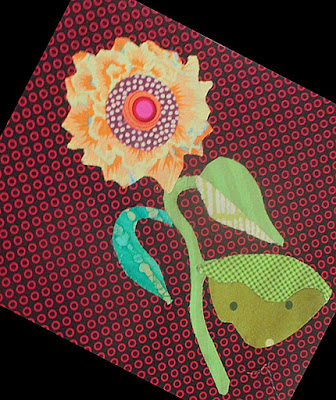Flora Delanica #5: Sunflower (Helianthus Annuus) by Becky Brown
The common sunflowers are native to the Americas.
Mary Delany's work reflects her lifelong interest in natural history. Collecting specimens whether botany or seas shells was a fashionable hobby at which she excelled.
One of Mary's mosaic grottoes
Friends paid many compliments to Mary Granville Pendarves Delany, among them that she liked to keep busy. Throughout her life she had energy and enthusiasm for several large-scale artistic projects including the encyclopedic paper mosaick albums she began in her seventies---her Flora Delanica. In her thirties the young widow took up grotto building on a rather grand scale.
Mary Pendarves spent summer, 1732 with
the Donnellen sisters in Killala along the North Atlantic shore.
Her inspiration was a seaside vacation she and longtime friend Anne Donnellen took while visiting Anne's sister Catherine in Ireland. Catherine was married to Robert Clayton, Protestant Bishop of Killala on the North Atlantic coast.
Anne Donnellen (ca.1700-1762) suggested
the extended visit trip to Ireland, perhaps to divert
Mary after an unhappy romance.
Shell-mosaic, Margrave Grotto, England
For centuries pilgrims collected
scallop shells to commemorate their visit to
Santiago de Compostela.
Not far from the Clayton's home was a hill on which Mary and friends were "erecting a grotto":
"On the summit of the hill is a natural grotto, with seats in it that will hold four people. We go every morning at seven o’clock to that place to adorn it with shells – the Bishop has a large collection of very fine ones; [Anne] and I are the engineers, the men fetch and carry for us what we want, and think themselves highly honoured."Mary closed this letter to her sister:
"I am now going to build a pyramid for the grotto."
St. James, the patron of shell collectors, in Pope's Grotto, Twickenham
Back in England a few years later Mary visited the famous grotto built by poet Alexander Pope, gathering inspiration we can assume. She spent many of her summers as guest of her close friend Margaret Duchess of Portland at Bulstrode in Buckinghamshire, where she worked on a grotto.
The Grotto in the Park at Bulstrode
1781 by S.H. Grimm, British Museum
"I go on making shell flowers for the ceiling of the chapel. I have made 86 large flowers and about 30 small ones." Mary in 1750
In her 1953 book Follies and Grottoes, Barbara Jones gives Mary Delany just a paragraph or two.
"She also designed and made or advised on a number of grottoes, notably a famous one at Bulstrode (now demolished) [pictured above] and her amusing letters often refer to follies: all the folly and grotto builders knew one another, and constantly visited and assessed one another's works----the references are innumerable.....In 1752 she gave a ball with one room decorated as a wood with a grotto...."
Mary helped her sister Anne Dewes with shellwork interior decoration at her home Wellesbourne Hall. In the mid 1750s she advised Anne's neighbors the Mordaunt sisters at Walton, Warwickshire on the mosaics in their octagonal bathhouse.
The shell work in the Mordaunts' octagonal bathhouse has been restored.
Mary's vision for the room was shell stalactites or icicles looking as if they'd been placed there by "an invisible sea nymph."
You can stay in the octagonal room.
The Bath House near Stratford on Avon is now a Landmark Trust site.
Sunflower by Barbara Brackman
Mary in her thirties, forties and fifties apparently spent many hours on scaffolds cementing shells to windows and ceilings. Looking at this mid-life work we can see the roots of the paper mosaics she created in her old age.
To see the original Helianthus annus go to the blog Late Bloomer and scroll down:
The Block
#5 Sunflower
Applique on the diagonal to an square cut 10-1/2" or on the vertical center of a rectangle cut 9-1/2" x 12-1/2".
One Way to Print the Pattern:
Create a word file or a new empty JPG file that is 8-1/2" x 11".Click on the image above.
Right click on it and save it to your file.
Print that file out 8-1/2" x 11". Note the inch square block for reference.
Adjust the printed page size if necessary.
Sunflower (Helianthus Annuus) by Nan Phillips in wool applique.
A Little More Mary
Delany
A bearded iris---hybrid.
Iris Squalens Dingy flower de Luce. Tall Bearded Iris
In 1732 on her first trip to Ireland Mary wrote about her pleasure in shell collecting with four friends:
"We took off in a boat and went to a shore about a mile off to gather shells, where we found a vast variety of beauties. We were very merry in our work...."
Sunflower by Ilyse Moore, wool on linen
Further Reading & Viewing
Lucy Worsley is portraying Mary Pendarves Delany here
in her new British series A Very British Romance. That's Mr.
Pendarves back there, I believe. Streaming now on PBS stations:
Poet Molly Peacock wrote a reflection on Mary Delany's life in 2011: The Paper Garden: Mrs. Delany Begins Her
Life's Work at 72. See a preview:
https://www.google.com/books/edition/The_Paper_Garden/4sgI9qkBuBAC?hl=en&gbpv=1&dq=molly+peacock+mary+delany&printsec=frontcoverMore about Irish grottoes and Mary Delany's role in the gardening fashion in James Howley & Roberto D'Ussy's The Follies and Garden Buildings of Ireland
https://www.google.com/books/edition/The_Follies_and_Garden_Buildings_of_Irel/xrwOGidTbKgC?hl=en&gbpv=1&bsq=delany
Mary's close friend Margaret Cavendish Bentinck Duchess of Portland was the queen of shell collecting.
Read Beth Fowkes Tobin's 2014 book: The Duchess's Shells: Natural History Collecting in the Age of Cook's Discoveries.
Barbara Jones, Follies and Grottoes, (1953 & 1974).























It is interesting to see the fads that come and go over time.
ReplyDeleteThis pattern is the 4th one I downloaded. Have I missed a block? I have #'s 1, 2 & 3 but have not seen the #4 Block.
ReplyDelete